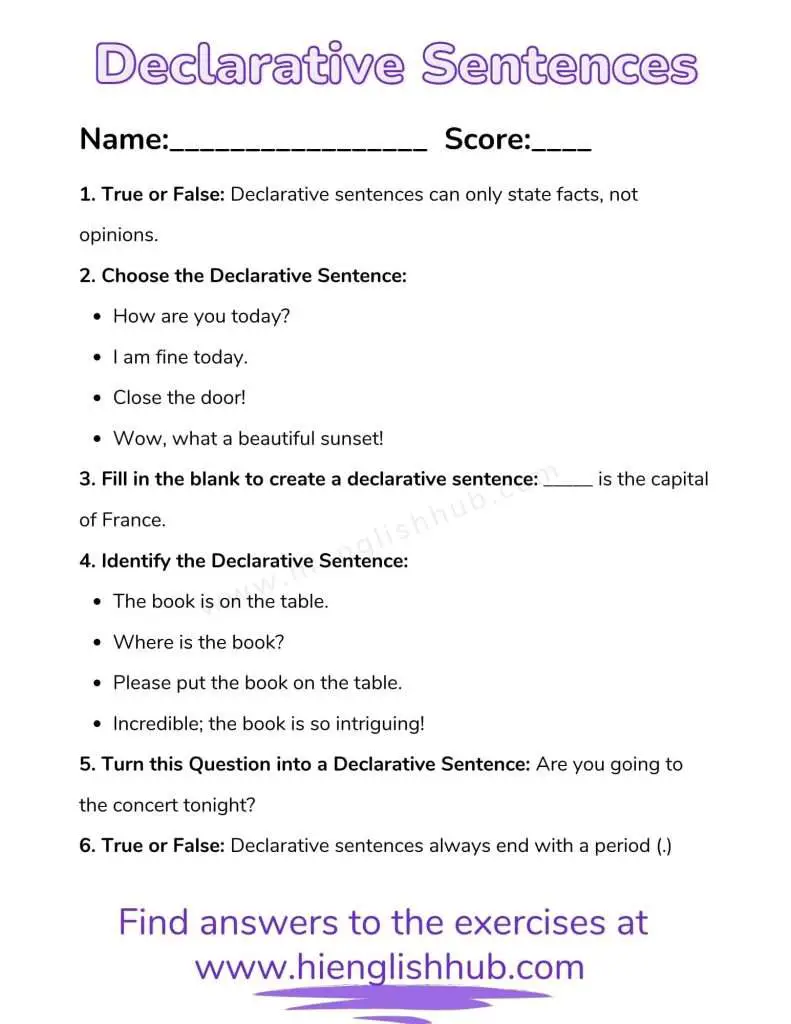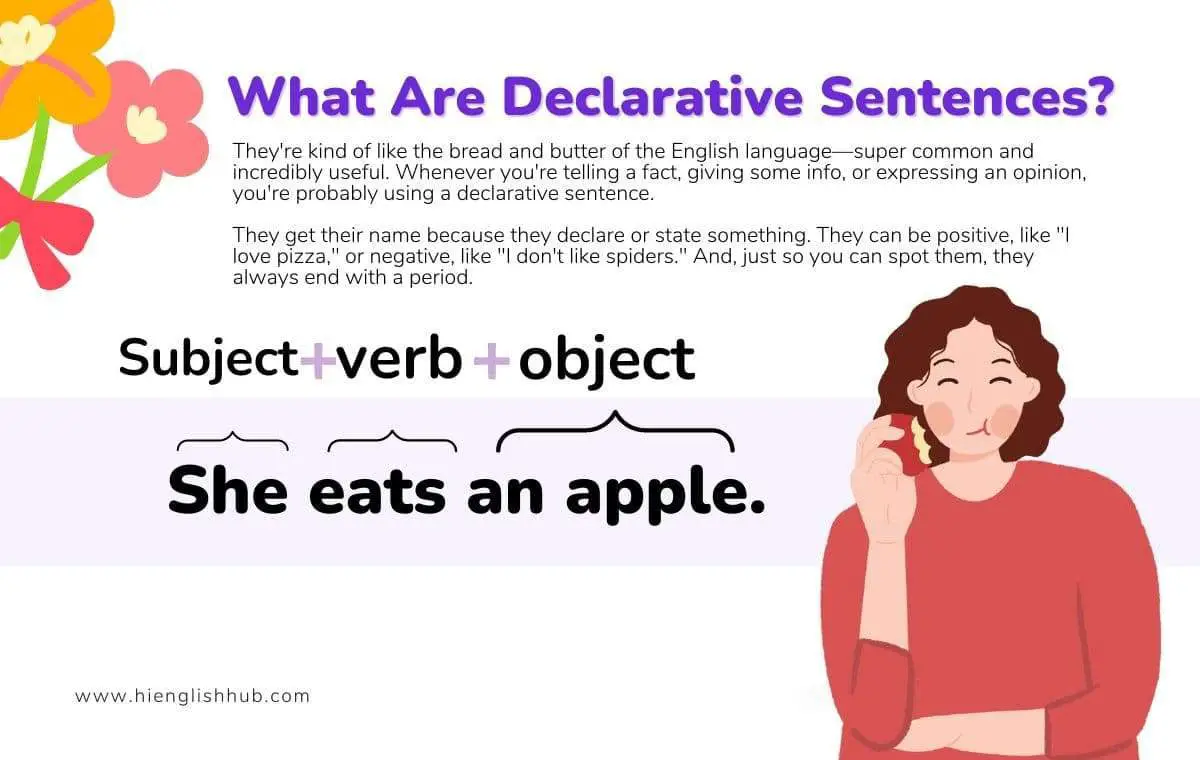Whether you’re a language enthusiast or simply curious about the power of words, you’re in the right place.
In this blog post, we’ll uncover the secrets behind declarative sentences—the backbone of clear and straightforward communication.
What Are Declarative Sentences?
So, you’re wondering what declarative sentences are, right?
Well, they’re kind of like the bread and butter of the English language—super common and incredibly useful. Whenever you’re telling a fact, giving some info, or expressing an opinion, you’re probably using a declarative sentence.
They get their name because they declare or state something. They can be positive, like “I love pizza,” or negative, like “I don’t like spiders.” And, just so you can spot them, they always end with a period.
They have a typical structure of Subject + Verb + Object (e.g., She eats an apple.). In this sentence, “She” is the subject, “eats” is the verb, and “an apple” is the direct object.
But the structure can be more complex depending on the sentence.
A more complex declarative sentence might be: “Despite the rainy weather, we decided to go to the park.” In this sentence, even though the structure is more complicated, it still makes a statement or expresses a fact.
Other Sentence types:
Types Of Declarative Sentences
| Sentence Type | Description | Example |
|---|---|---|
| Simple | Express a complete thought with a subject and a predicate. | The cat is sleeping. |
| Compound | Consist of two or more independent clauses joined by conjunctions. | I love to read, and my brother enjoys video games. |
| Complex | Comprise one independent clause and at least one dependent clause. | After I finish my homework, I will go to the movies. |
| Compound-Complex | Contain two or more independent clauses and at least one dependent clause. | She studied hard for the exam, but she still felt nervous because she hadn’t prepared adequately. |
Positive And Negative Declarative Sentences
Positive and negative declarative sentences are two different forms of statements that express either an affirmative or negative condition or fact.
A positive declarative sentence affirms or states something as true, factual, or existing. For example: “The sun is shining brightly.”
A negative declarative sentence, on the other hand, negates or denies a condition or fact. It expresses the absence or non-existence of something. For example: “The cat is not on the couch.”
Both positive and negative declarative sentences play a crucial role in expressing information and making statements, allowing us to convey a wide range of ideas and facts.
Examples Of Declarative Sentences
Let’s dive into some examples of declarative sentences.
1. Truth or Dare questions can make parties more fun.
2. Kids learn to spell numbers from 1 to 100 in grade school.
3. Irregular verb forms make English challenging to learn.
4. Reported speech helps us share what others have said.
5. Text abbreviations can speed up chat conversations.
6. Procrastination often delays our work.
7. Learning English is important because it’s used worldwide.
8. I enjoy taking long walks in the park on sunny days.
9. She decorated her room with colorful artwork and vibrant curtains.
10. I purchased a cute piggy bank from Amazon for my daughter to encourage her to save money.
Common Mistakes To Avoid When Constructing Declarative Sentences
| Common Mistakes | Description | Example | Corrected Version |
|---|---|---|---|
| Run-on sentences | Failure to appropriately separate independent clauses. | I went to the store I bought some groceries. | I went to the store and bought some groceries. |
| Subject-verb agreement | Inconsistency between the subject and verb in terms of number or tense. | The dogs barks loudly. | The dogs bark loudly. |
| Incorrect word order | Disarranging words that disrupt sentence clarity or meaning. | To the store I went yesterday. | I went to the store yesterday. |
| Inconsistent verb tense | Incoherent use of past, present, or future tense. | He sings a song and danced to the music. | He sings a song and dances to the music. |
| Lack of parallelism | Failure to maintain parallel structure in lists or comparisons. | I like swimming, hiking, and to read books. | I like swimming, hiking, and reading books. |
Quiz Your Knowledge: Declarative Sentence Challenge

1. True or False: Declarative sentences can only state facts, not opinions.
2. Choose the Declarative Sentence:
- How are you today?
- I am fine today.
- Close the door!
- Wow, what a beautiful sunset!
3. Fill in the blank to create a declarative sentence: _____ is the capital of France.
4. Identify the Declarative Sentence:
- The book is on the table.
- Where is the book?
- Please put the book on the table.
- Incredible; the book is so intriguing!
5. Turn this Question into a Declarative Sentence: Are you going to the concert tonight?
6. True or False: Declarative sentences always end with a period (.)
Answers:
- False – Declarative sentences can state facts or opinions and provide information.
- I am fine today. – This sentence provides information about the speaker’s state of being, indicating that they are fine on that particular day. Thus, it’s declarative.
- Paris is the capital of France. – This is a declarative sentence stating a fact.
- The book is on the table. – This sentence provides information, so it’s a declarative sentence.
- You are going to the concert tonight. – This is a declarative sentence stating an assumed fact.
- True – Declarative sentences always end with a period (.)
FAQs On Declarative Sentences
What are 10 examples of declarative sentences?
1. She enjoys playing the piano.
2. My favorite color is blue.
3. I have a meeting tomorrow at 9 AM.
4. Dogs are loyal animals.
5. The Eiffel Tower is located in Paris.
6. The book on the table is mine.
7. Today is Tuesday.
8. The train arrives at 8 o’clock.
9. The sky is blue.
10. My grandmother’s house is always warm and welcoming.
How do you know if a sentence is declarative?
To identify a declarative sentence:
– Check if it has a subject and predicate, expressing a complete thought.
– See if it presents a fact, opinion, or provides information.
– Note that declarative sentences do not ask questions or give commands.
– They typically have a neutral tone.
How to tell the difference between declarative and imperative sentences?
Distinguishing between declarative and imperative sentences can be done by observing both the structure and intent of the sentence.
Declarative Sentences:
Structure: Declarative sentences typically have a subject before the verb. They are structured as Subject + Verb + (Object).
Intent: These sentences state facts and opinions or provide information.
For example:
– I am going to the store.
– I love coffee.
Imperative Sentences:
Structure: Imperative sentences often lack a visible subject and typically begin with a verb. The subject is usually an implied ‘you.’
Intent: These sentences give orders, instructions, advice, or express requests or commands.
For example:
– Go to your room. (the implied subject is ‘you’)
– Please finish your homework.
What is the punctuation mark for a declarative sentence?
The punctuation mark for a declarative sentence is a period (.)
What are the uses of declarative sentences?
Declarative sentences are used to state facts, describe situations or events, give directions, and express personal thoughts and feelings. They are the most common type of sentences used in everyday language, written texts, academic writing, and professional communication.
Wrapping Up On declarative sentences
Declarative sentences are the cornerstone of effective communication.
By mastering their definition and usage, you can express your thoughts and convey information with precision.
I hope this blog post has shed light on the various types of declarative sentences and their significance in everyday communication.
Before you leave, share this post with others who might benefit from a deeper understanding of declarative sentences, and don’t forget to follow Hi English Hub on Pinterest and Twitter for more language tips and insights.

